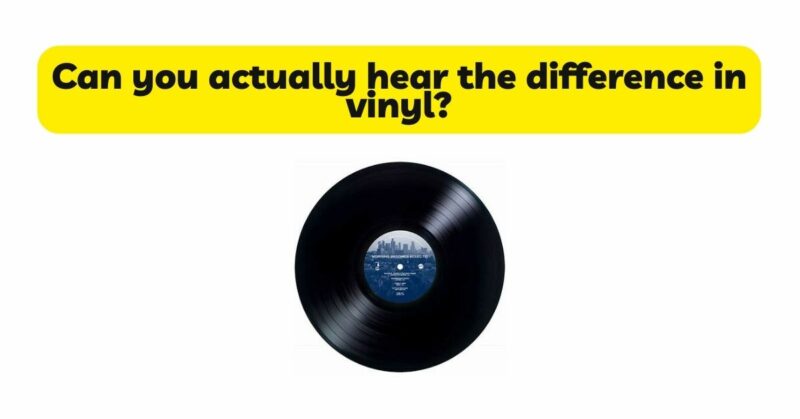Vinyl records have long been celebrated for their unique sound and tactile appeal. Audiophiles and music enthusiasts often assert that vinyl offers a distinct listening experience compared to digital formats. In this article, we will delve into the question of whether you can actually hear the difference in vinyl. By examining the technical aspects, the mastering process, and the subjective nature of sound perception, we can gain insights into the audible differences that make vinyl records a cherished medium for music lovers.
- Analog vs. Digital Sound: Vinyl records produce sound through an analog process, where physical grooves are decoded by a stylus, resulting in the creation of sound waves. On the other hand, digital formats use a series of numerical samples to recreate sound. The fundamental difference in sound generation between analog and digital formats lays the groundwork for potential audible distinctions.
- Warmth and Character of Vinyl: Vinyl records are often praised for their warmth, richness, and unique character. Some listeners claim that vinyl offers a more organic and immersive sound experience compared to digital formats. The inherent imperfections and slight variations in playback contribute to the charm and character of vinyl, creating a distinct sonic signature.
- Dynamic Range and Sound Fidelity: Vinyl records, with their analog nature, can offer a wider dynamic range compared to heavily compressed digital formats. This means that the subtle nuances and dynamics in the music are often better preserved on vinyl, resulting in a more natural and authentic listening experience. The vinyl medium can faithfully reproduce both the softest whispers and the most explosive crescendos.
- Vinyl Mastering Process: The process of mastering music for vinyl is unique and requires specialized techniques. Engineers consider the physical limitations of vinyl, such as groove spacing and groove width, when preparing the audio for pressing. These considerations impact the overall sound quality and can contribute to the distinct audio characteristics associated with vinyl records.
- Surface Noise and Pops: Vinyl records are not without their imperfections. Surface noise, including clicks, pops, and crackles, can be present due to dust, scratches, or the inherent nature of the vinyl medium itself. While some may perceive these imperfections as part of the vinyl charm, others might find them distracting. The presence of surface noise is a subjective aspect of the vinyl listening experience.
- Listener Subjectivity and Emotional Connection: Sound perception is a deeply subjective experience influenced by personal preferences, memories, and emotions. The tangible nature of vinyl records, the act of carefully handling and placing the needle on the record, and the ritual of listening can contribute to a heightened sense of engagement and emotional connection. These factors can shape the perceived differences in sound when compared to digital formats.
- Equipment and Setup: The playback equipment and setup used to listen to vinyl records play a crucial role in the overall sound quality and the ability to discern differences. High-quality turntables, cartridges, amplifiers, and speakers, along with proper calibration and maintenance, can significantly enhance the vinyl listening experience and reveal the nuances that differentiate it from digital formats.
- Personal Listening Preferences: Ultimately, whether one can hear the difference in vinyl comes down to personal listening preferences. Some individuals may have a heightened sensitivity to the nuances of vinyl, while others may not discern significant differences or may even prefer the convenience and consistency of digital formats.
Conclusion: While the audible differences in vinyl records compared to digital formats are a subject of ongoing debate, many listeners assert that vinyl offers a distinct and engaging listening experience. Factors such as warmth, dynamic range, mastering techniques, surface noise, and personal listening preferences all contribute to the perceived differences. The analog nature of vinyl, along with the ritualistic and tactile experience it provides, adds an emotional and immersive dimension to thelistening journey.As you embark on your own vinyl experience, take the time to appreciate the unique qualities that vinyl records offer. Embrace the warmth, character, and dynamic range that can make vinyl sound distinct. Explore the mastering process and the craftsmanship that goes into creating vinyl records. Recognize that sound perception is subjective, and personal preferences play a significant role in determining whether one can hear the differences in vinyl.Whether you find vinyl to be a superior format or simply appreciate its nostalgic appeal, the enjoyment of music is ultimately a deeply personal and subjective experience. Embrace the diversity of formats and the multitude of ways in which music can be enjoyed. From vinyl records to digital streams, each offers its own unique qualities and appeals to different sensibilities.In the end, the question of whether you can actually hear the difference in vinyl is best answered by embarking on your own vinyl journey. Immerse yourself in the rituals, appreciate the imperfections, and let your ears and heart guide you in discovering the unique qualities that vinyl records bring to the world of music.


